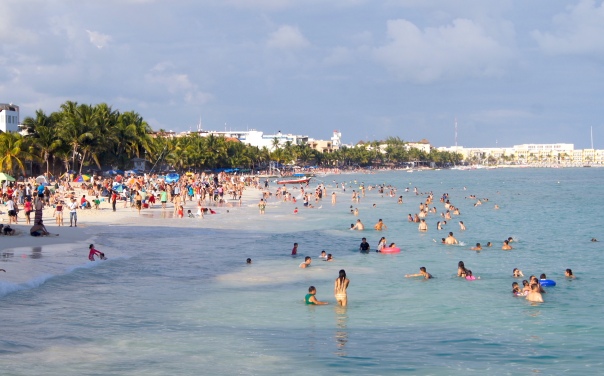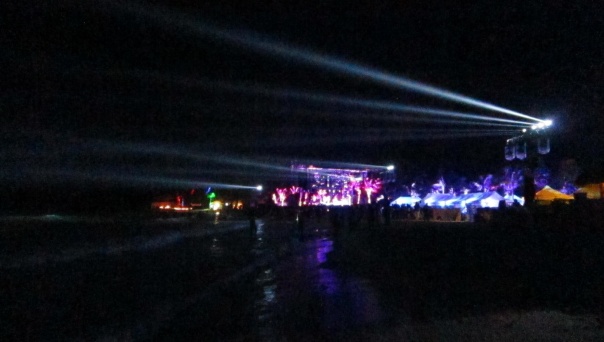https://nohaybronca.wordpress.com/2017/11/14/15-money-saving-tips-for-cancun-and-the-mayan-riviera/
15 Money-Saving Tips for Cancun and the Mayan Riviera
Posted by Ted Campbell
How to save money and avoid getting ripped off in Cancun, Playa del Carmen, and Tulum
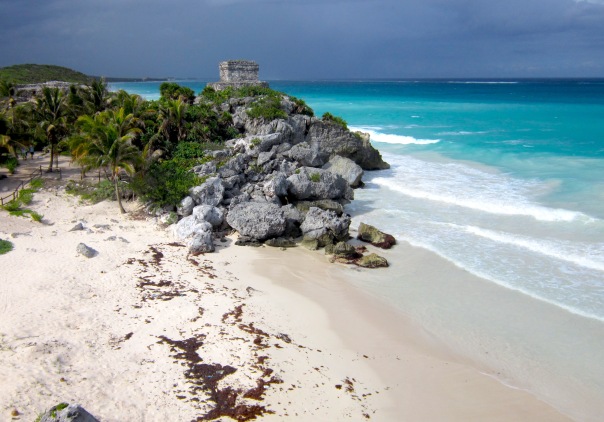
From Cancun to Tulum, the Mayan Riviera is 90 miles of white-sand beaches, small towns, and big resorts between the deep jungle of the Yucatan Peninsula and the calm turquoise water of the Caribbean Sea.
Fortunately, this paradise can be quite affordable. Sure, staying at one of the fancy resorts can cost hundreds or even thousands of dollars a night. But search out smaller hotels and eat in local restaurants in Playa del Carmen, Tulum, Puerto Morelos, or downtown Cancun, and you may find that a vacation in the Mayan Riviera is cheaper than staying home.
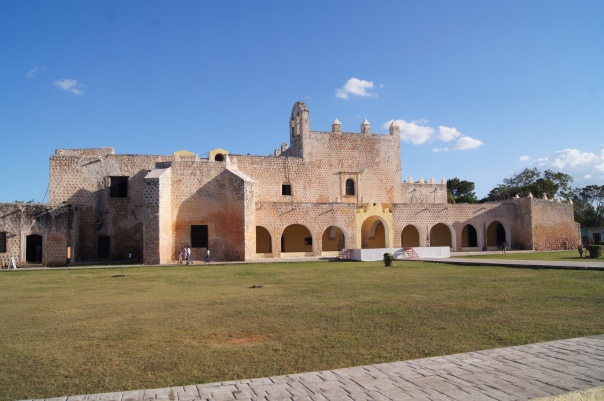
Elsewhere on this blog you can find my article Top Tips for Travelers to Mexico, which lists all the important ways you can minimize your expenses and maximize your fun on a trip to Mexico.
There’s some overlap with the tips on this list, but as the title suggests, these are specific to the Mayan Riviera, one of the most beautiful and interesting parts of Mexico—perhaps even the world.
1. Stay in a small hotel a block or two from the beach
The huge resorts in Cancun’s hotel zone and in other parts of the Mayan Riviera are a lot of fun, with all-day pool parties, unlimited booze, and all-you-can-eat restaurants.
Similarly, the fancy hotels right on the beach in smaller towns are lovely, that’s for sure. And while they may be cheaper than the big resorts or a similar hotel in your home country, if you are really looking to save money, you can find great value if you search for a hotel away from the beach.
By great value, I’m talking about as low as 200 pesos a night (about $10-12 USD) for a modest but reasonable room, nothing fancy but a decent place to crash. For a little more, say 400-600 pesos (about $20-35 USD) you can get something perfectly good, with a TV, hot water, and air conditioning.
Look for cheaper hotels in downtown Cancun (the beach is a 20-minute ride away on a local bus), two or three blocks from the beach in Playa del Carmen, in Tulum town (which is on the highway, not on the beach), or just off the beach practically anywhere else on the Mayan Riviera.
You can search for hotels online, but the best way to find the cheapest hotels is just by wandering around and looking for them, which is easy to do in low season.
2. Avoid high season
If at all possible, don’t go during high season, which is late December to early January, Semana Santa (the week before Easter), and late July. Besides more crowds, many hotels raise prices during those times.
If you can only visit during a high season, however, don’t cancel your trip—just give yourself a little more time to visit popular places like the Mayan ruins of Tulum or Chichen Itza.

3. Don’t pay in U.S. dollars
Use pesos for everything, especially for souvenirs and meals. Although many restaurants and stores accept dollars, the exchange rate they use will be outrageous, automatically adding 10% (or more) to the price.
Exceptions to this are big nightclubs like Coco Bongo and the big adventure parks like Xel-Ha, which have fixed fees in U.S. dollars.
4. Get pesos from an ATM
Exchange rates from bank ATMs are usually good, much better than changing money at the booths in the Cancun airport.
Make sure you use a bank, not a “private” ATM, which charge higher fees. Banks are all over downtown Cancun and in Playa del Carmen, and you can find bank ATMs in bus stations too.
Basically, if you see a machine on the street or in a restaurant with only “ATM” written on it and no bank logo, then you can be sure it’s a private ATM and will charge high fees and perhaps even give a bad exchange rate.
Common banks in Mexico include Bancomer, Banamex, Santander, Banorte, HSBC, and Scotiabank. Look for these to save on fees when withdrawing money.

5. Ignore the “tour guides” on the street
As you walk around Quinta Avenida in Playa del Carmen (5th Avenue, the long pedestrian street that follows the beach), guides will constantly call out to you, offering nightclub tickets, trips to ecoparks and ruins, trips to Cozumel…pretty much any activity you can imagine.
Sure, talk to these guys and ask them questions, but keep in mind that you don’t need them for anything. Taking public transportation to Tulum or Chichen Itza is easy. For Cozumel or Isla Mujeres, simply go to the ferry terminals. For the big adventure parks like Xel-Ha or Xplor, buy tickets online (more on this below).
It’s possible that these “guide” have discounted tickets for nightclubs, but before buying them, stop by the nightclub (or check online) to find out the regular price.
6. Buy tickets online for ecoparks and shows
If you want to go to one of the heavily-advertized theme parks like Xel-Ha, Xplor, or Rio Secreto, always check the prices online—they all have websites in English. Besides offering inflated prices, the salespeople on the street may pressure you into a package you don’t want or don’t understand.
7. Take public transportation to Chichen Itza and Tulum
If you read this article about Chichen Itza, you’ll know that I’m not a big fan of guided tours. For the famous Mayan ruins like Tulum and Chichen Itza, you can just show up in the morning when they open. (Go extra early in high season, however.) Then you can enjoy the site without being part of a big, noisy group. You can stay as long as you want and search out all the hidden corners.
Besides, it’s cheaper to take public transportation. Colectivos (passenger vans) constantly travel along the coast. In the towns they leave from specific places—easy to find, or ask at the front desk of your hotel. On the highway, all you have to do is wave at them. If one has space, it will stop for you.
And by cheap, I mean between $1 and $3 USD. (But pay in pesos, of course.)
For places inland, you can take the modern and safe ADO buses, which leave from bus stations in every town. Check schedules and prices on their website. At the moment it’s only in Spanish, but easy enough to figure out.
8. About resort and timeshare sales pitches
Some resorts offer a free drink and access to their swimming pool if you listen to their sales pitch. In my opinion, this is a huge waste of an afternoon, but go for it if you’re interested.
Ignore anyone offering this outside of the resort itself, or if someone wants to tell you about a timeshare opportunity. Listen if you want, but by no means give them any personal information, such as the name of your hotel.

9. On buying souvenirs
The same souvenirs are available everywhere—in stores, in markets, and from people walking around the beach.
The rule is, basically, the farther away you are from the beach or places with lots of tourists, the better the prices will be. So this means never buy from someone offering you something on the beach. (Unless you want to, of course, but understand that the prices will be higher.)
Don’t buy anything on Cozumel—prices are higher by like 200%. Cruise ships dock in Cozumel, and every day thousands of tourists pour out of them. They have no idea what the peso is worth and get ripped off like crazy.
The same goes for Isla Mujeres—even though there are no cruise ships, the tourists there are a captive audience. It’s an island, after all.
So, for your best deal on a souvenir, head to a place with lots of shops in one place. In Playa del Carmen there are a bunch of small shops just inland from the Cozumel dock, and in downtown Cancun there are several markets like Mercado 28 or Mercado 23 that are full of souvenirs.
10. On buying souvenirs in markets
Probably the best market for souvenirs is Mercado 28 in downtown Cancun, an easy walk from the ADO bus station. Lots of vendors means lots of competition between them, meaning lower prices.
The downside is that the vendors constantly call out to you as you walk around. You may find it annoying, but just ignore them. Don’t get excited about something you like, just calmly ask the price and move on. You’ll almost certainly see the same thing elsewhere—ask the price again, and keep looking until you hear a price you like. Which brings us to…
11. Haggling
In markets and souvenir shops, if you don’t see price tags, then get ready to haggle. Expect to be quoted higher prices if you don’t speak Spanish.
Don’t show any emotion when haggling, positive or negative, like saying how nice the product is. Just ask for the price, and then either offer a lower price or ask for a discount. If you don’t like the price, thank them and leave.
When you start leaving, usually they say nothing. In this case, yes you’ve been given the final price. Go look in other shops for the same thing or come back to buy it.
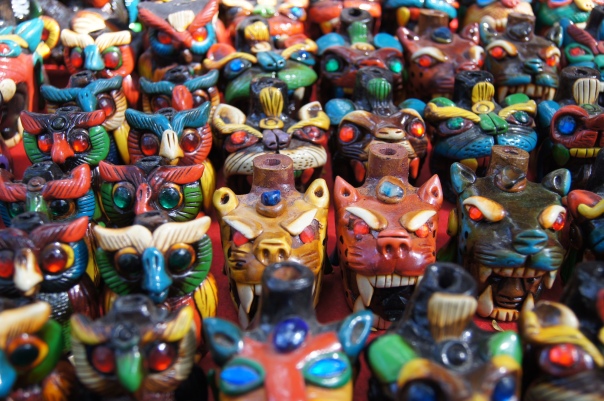
Sometimes, however, when you start to leave they will stop you and give you a lower price. When this happens, the real haggling begins. You can probably get an even lower price than what they offered.
But please don’t do this when buying fruit or some non-souvenir in a regular market. Typically you get the real price when shopping for food, and haggling over nickels and dimes for a bag of oranges or a loaf of bread is a little rude.
12. The Russian Discount
I noticed this first in Moscow, which is why I call it the “Russian Discount.” A big sign in the souvenir shop window says “Everything 50% Off!”
Check the prices—I’ve noticed that, almost always, everything in the shop costs double what other stores charge, so your 50% discount really isn’t a discount at all.
13. Eating in
If you have a hotel that includes free breakfast, you will automatically save money by not going out for breakfast every day. The free hotel breakfast will also save time, especially with a big group—not discussing where to go, waiting for a table, looking at the menu…
If your hotel has a kitchen, you can save even more money by eating in. I’m not talking about cooking a huge feast—it’s your vacation after all, maybe you don’t want to make such an effort—but it’s a good idea to buy some fruit or supplies for sandwiches, which is particularly convenient to bring along on a day trip.
14. Choosing restaurants
Same as with souvenirs—the closer you are to the beach or a place full of tourists, the more expensive the restaurants will be.
But it’s not only price—the Mexican restaurants geared toward tourists are not only more expensive, but also not nearly as good. For authentic Mexican food—obviously much more delicious than the bland stuff made for tourists—look for modest restaurants away from the beach, such as in downtown Cancun or three blocks from the beach in Playa del Carmen.
The best way to find these places is to ask a local, but not a cab driver or even the person at the front desk of your hotel, as they will probably send you to their friend’s touristy restaurant.
Whoever you ask, make it clear that you want something real, what the locals eat.

15. Check your bill carefully
Overcharging is common—adding a few more beers to the count, thinking you won’t notice. Make sure you actually ordered everything on your bill.
Tip 10%, but check to see if it was included already.
Pay in cash, not with a credit card. If the wrong person gets hold of your number, they can empty your bank account. Besides, if you use your credit card for every meal, it will be hard to keep track of all the expenses—which ones are correct, which are not.
Bonus Tip: Buy my guidebook
Shameless plug: All these tips and many more are detailed in my guidebook to the region, the Cancun and Mayan Riviera 5-Day Itinerary. It’s for the independent traveler who likes the beach but also wants some culture. Besides saving a lot of money, you:
- Have two full days on two gorgeous beaches: Cancun and Playa del Carmen.
- Explore two Mayan ruins: Chichén Itzá, one of the new Seven Wonders of the World, and Tulum, a sunny fortress built on cliffs overlooking one of the most iconic beaches in Mexico.
- Dip your toe into local culture in Valladolid, a small colonial town in central Yucatán.
- Swim, snorkel, or scuba dive in the clear, freshwater Dos Ojos cenote.
- Eat what Mexicans eat: seafood, tacos, and Yucatán specialties like panuchos and salbutes.
- Shop, party, get tan, and learn some Spanish, history, and culture. And, if time permits, explore more places in the region, including Puerto Morelos, Isla Mujeres, Cozumel, the Cobá ruins, Xpu-Ha beach, and many more.
You can get a free Kindle reader from Amazon to read the guide on your computer, or you can now buy a paperback version.
This part of Mexico may be the most visited, but in some ways the least understood. I try to remedy this with my guide.
From Amazon:
Please leave a comment if you have a question about any of these tips or my guide.
Advertisements
5 Days in Cancun on a budget - What to do?In "Mayan Ruins"
7 Tips for Budget Travel in Cancun and the Mayan RivieraIn "Learning Spanish"
Top 12 Places in Cancun and the Mayan Riviera, MexicoIn "Mayan Ruins"
About Ted Campbell
U.S.-Canadian writer, translator and university teacher in Mexico. Travel stories and practical tips on my blog No Hay Bronca: nohaybronca.wordpress.comTwitter: @NoHayBroncaBlog // Contact: nohaybroncablog (at) gmail.com
Posted on November 14, 2017, in Lessons from the Road, Mexico, Travel in Mexico and tagged budget travel, cancun, cancun hotel, chichen itza, mexico travel, mexico travel tips, playa del carmen, Puerto Morelos, tulum. Bookmark the permalink. 1 Comment.
